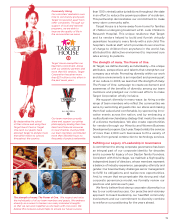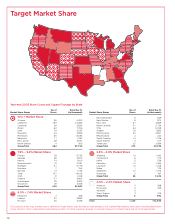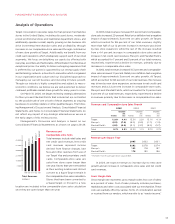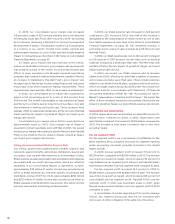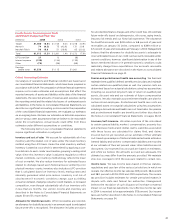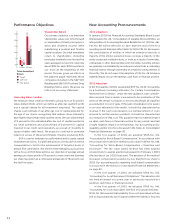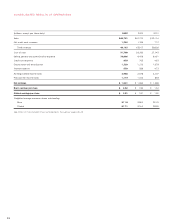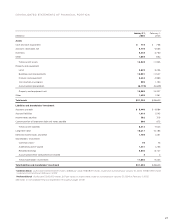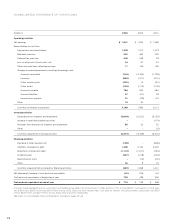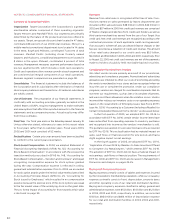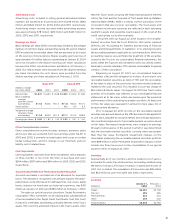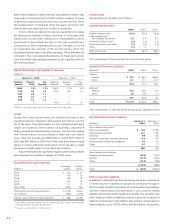Target 2003 Annual Report Download - page 27
Download and view the complete annual report
Please find page 27 of the 2003 Target annual report below. You can navigate through the pages in the report by either clicking on the pages listed below, or by using the keyword search tool below to find specific information within the annual report.
25
instead of recognizing the liability at the date of commitment to
an exit plan as was previously allowed. The adoption of SFAS
No. 146 did not have a material impact on current year or previously
reported net earnings, cash flows or financial position.
In the second quarter of 2003, we adopted SFAS No. 149,
“Amendment of Statement 133 on Derivative Instruments and
Hedging Activities.” SFAS No. 149 amends and clarifies accounting
for derivative instruments, and is effective for contracts entered
into or modified after June 30, 2003. The adoption of SFAS
No. 149 had no material impact on current year or previously
reported net earnings, cash flows or financial position.
In the third quarter of 2003, we adopted SFAS No. 150,
“Accounting for Certain Financial Instruments with Characteristics
of both Liabilities and Equity.” SFAS No. 150 clarifies the classification
and measurement of certain financial instruments with characteristics
of both liabilities and equity, and is effective for financial instruments
entered into or modified after May 31, 2003, or otherwise for the
first interim period beginning after June 15, 2003. The adoption of
SFAS No. 150 had no material impact on current year or previously
reported net earnings, cash flows or financial position.
In the fourth quarter of 2003, we adopted EITF’s Issue
No. 03-10 “Application of Issue 02-16 by Resellers to Sales Incentives
Offered to Consumers by Manufacturers” (EITF No. 03-10) which
amends EITF No. 02-16. According to the amended guidance, if
certain criteria are met, consideration received by a reseller in the
form of reimbursement from a vendor for honoring the vendor’s
sales incentives offered directly to consumers (i.e. manufacturer’s
coupons) should not be recorded as a reduction of the cost of the
reseller’s purchases from the vendor. The adoption of EITF No. 03-10
did not have a material impact on current year or previously reported
net earnings, cash flows or financial position. Our accounting policy
regarding vendor income is discussed in the Notes to Consolidated
Financial Statements on page 30.
In the fourth quarter of 2003, we adopted SFAS No. 132(R),
“Employers’ Disclosures about Pensions and Other Postretirement
Benefits — an amendment of FASB Statements No. 87, 88 and 106,”
which revises the annual and interim disclosure requirements
about pension and other postretirement benefits.
2002 Adoptions
In the first quarter of 2002, we adopted SFAS No. 142, “Goodwill
and Other Intangible Assets,” which superseded Accounting
Principles Board (APB) Opinion No. 17, “Intangible Assets.” Under
the new statement, goodwill and intangible assets that have
indefinite useful lives are no longer amortized but rather reviewed
at least annually for impairment, or more frequently if impairment
indicators arise. In both 2003 and 2002, the adoption of this
statement reduced annual amortization expense by approximately
$10 million (less than $.01 per share). Our accounting policy
regarding intangible assets is discussed in the Notes to Consolidated
Financial Statements on page 32.
In the first quarter of 2002, we adopted SFAS No. 144,
“Accounting for the Impairment or Disposal of Long-Lived Assets.”
The guidance requires companies to review long-lived assets when
events or changes in circumstances indicate that the carrying value
of the asset may not be recoverable. In both 2003 and 2002,
impairment losses resulted in a financial statement impact of less
than $.01 per share. Our accounting policy regarding impairment
of long-lived assets is discussed in the Notes to Consolidated
Financial Statements on page 32.
In the first quarter of 2002, we adopted SFAS No. 145,
“Rescission of FASB Statements No. 4, 44 and 64, Amendment of
FASB Statement No. 13, and Technical Corrections.” Previously, all
gains and losses from the early extinguishment of debt were
required to be aggregated and classified as an extraordinary item
in the Consolidated Results of Operations, net of the related tax
effect. Under SFAS No. 145, gains and losses from the early
extinguishment of debt are included in interest expense. Prior year
extraordinary items have been reclassified to reflect this change.
The adoption of SFAS No. 145 had no impact on net earnings, cash
flows or financial position.
Forward-looking Statements
This Annual Report, including the preceding Management’s
Discussion and Analysis, contains forward-looking statements
regarding our performance, liquidity and the adequacy of our capital
resources. Those statements are based on our current assumptions
and expectations and are subject to certain risks and uncertainties
that could cause actual results to differ materially from those
projected. We caution that the forward-looking statements are
qualified by the risks and challenges posed by increased competition
(including the effects of competitor liquidation activities), shifting
consumer demand, changing consumer credit markets, changing
health care costs, changing capital markets and general economic
conditions, hiring and retaining effective team members, sourcing
merchandise from domestic and international vendors, investing
in new business strategies, achieving our growth objectives, the
review of strategic alternatives, the outbreak of war and other
significant national and international events, and other risks and
uncertainties. As a result, while we believe that there is a reasonable
basis for the forward-looking statements, you should not place
undue reliance on those statements. You are encouraged to review
Exhibit (99)C attached to our Form 10-K Report for the year-ended
January 31, 2004, which contains additional important factors that
may cause actual results to differ materially from those projected
in the forward-looking statements.


